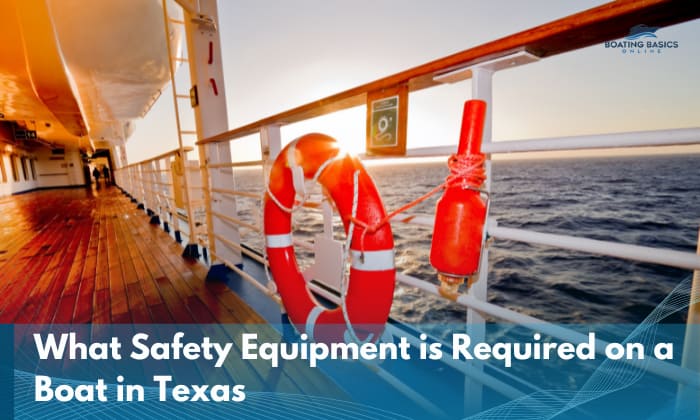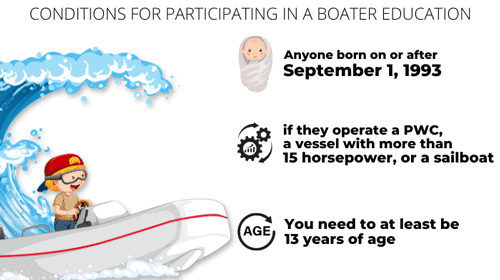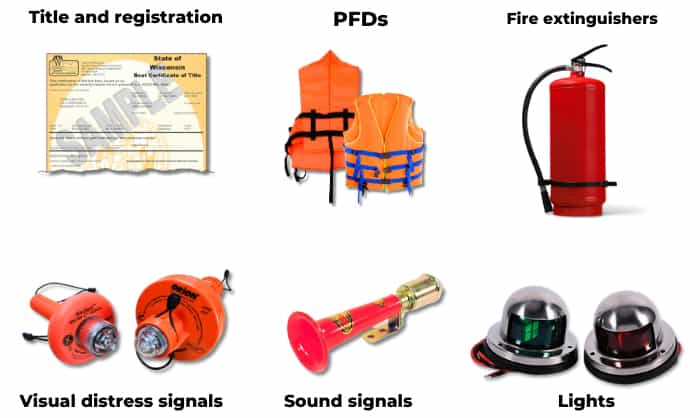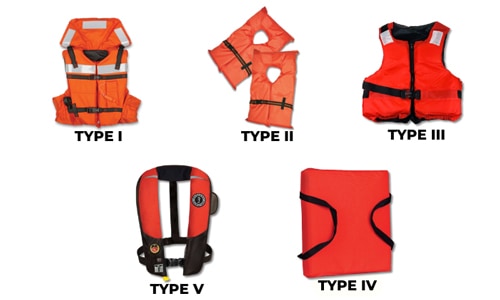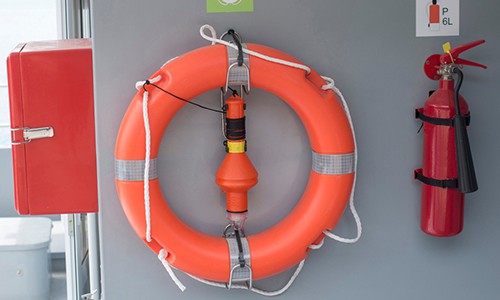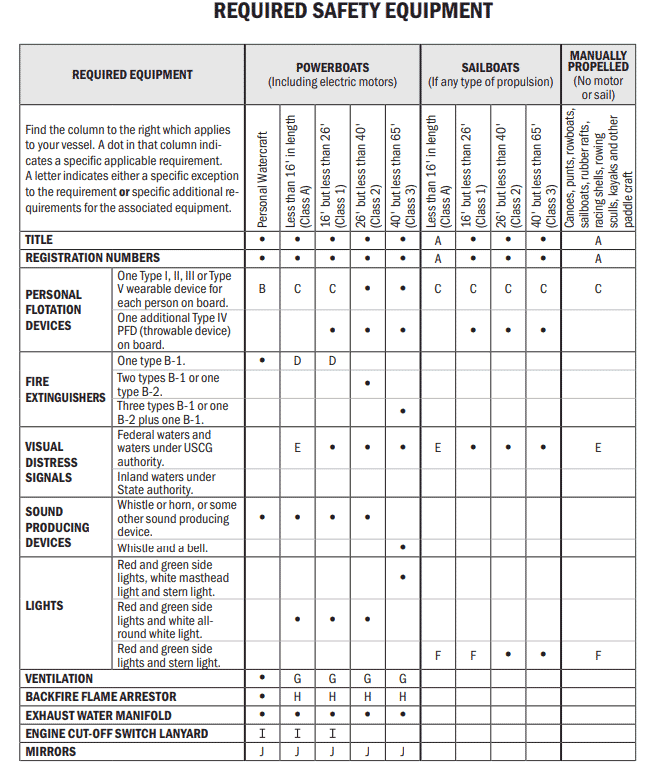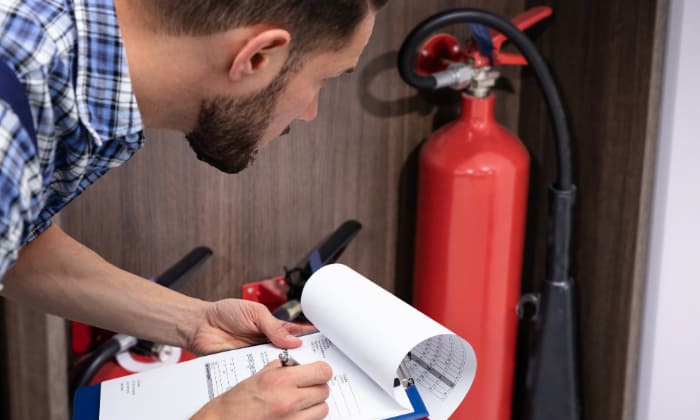If you want to know the exact, verified answers to your question, “What safety equipment is required on a boat in Texas?” these are the fundamentals:
- U.S. Coast Guard-approved PFDs (Personal Flotation Devices)
- Fire extinguishers
- Whistle or horn
- Red flares and other applicable visual distress signals
- Ventilation systems
- Navigation lights
- Mirrors
- Backfire flame arrestors
- Lanyard-type engine cut-off switch (ECOS)
- Boat title and registration
You need to be aware of the type and number of PFDs and fire extinguishers you must bring based on your vessel’s size and type. Continue reading to know the specifics.
Table of Contents
Overview of Texas Boating Laws
These are the basic boat rules and boat requirements in Texas:
1. Boater Education and Minimum Age
Anyone born on or after September 1, 1993, is required to finish a boater education course if they operate a PWC, a vessel with more than 15 horsepower, or a sailboat. You need to at least be 13 years of age to operate them.
2. Operating Under the Influence
Sec. 49.06 of the Texas Penal Code reiterates that operating a boat while intoxicated is illegal. Intoxication means failing to use physical and mental faculties due to alcohol or drug intake. The same goes for individuals found with an alcohol concentration of 0.08%.
3. Reckless Operation
This means putting yourself and your passengers at risk while you’re operating your boat. For example, don’t let anyone sit on the gunwale or transom, which puts them at risk of getting thrown overboard.
4. Speed Limits
There’s no set speed limit in the state, and overall common sense regarding safe speed levels is encouraged. “Excessive speed” is dissuaded, especially in crowded areas, and laws make it clear that you may be cited for it.
Specific Requirements for Safety Equipment on a Boat in Texas (Must-have)
Based on my research and the table above, these are the boat safety gear you must bring with you regardless of the type of vessel you’re operating. At best, these are the things you need on a boat (aka must-haves), and you should never be caught without them in order to avoid any legal consequences.
- Title and registration (justf keep this in your boat every time you operate it)
- The appropriate type and number of PFDs
- The correct type and number of fire extinguishers
- Visual distress signals
- Sound signals
- Lights
1. Personal Flotation Devices
All watercraft must have at least one USCG-approved PFD (Type I, II, III, or V) for every passenger on board. Those younger than 13 years are required to wear such a PFD as long as the vessel is underway.
Here is the explanation of each type:
- Type I – these are offshore life jackets excellent for dangerous and remote waters. They’re designed to keep a person afloat and facing up even if they become unconscious.
- Type II – these life jackets are suited for use in calmer waters. They may keep you afloat, but they may not be as effective as Type I in keeping the wearer face up.
- Type III – these are flotation aids suitable to calm waters only. They’re commonly used by skiers and wakeboarders.
- Type IV – also known as throwable PFDs, they’re meant to keep someone afloat but aren’t necessarily wearable.
- Type V – these are special-use PFDS that are customized for kayakers and wakeboarders.
Vessels spanning 16 feet or more need to have at least one USCG-approved Type IV PFD, aside from Type I to III wearable flotation device. As for children younger than 13 years of age, they must wear a Type I, II, III, and IV life jacket at all times while traveling by water.
2. Fire Extinguishers
You will need to bring these safety items if your boat has:
- Enclosed living spaces and closed compartments that can fit portable fuel tanks and other flammable objects.
- Permanent fuel tanks.
- An inboard engine.
- Unsealed double bottoms with inadequate flotation material.
As for the type of fire extinguishers that are applicable for motorboats in Texas, know that you can only bring either class B or BC, which are applicable to gas/oil fires. What makes type BC fire extinguishers different is that they can also handle electrical fires.
Fire extinguishers are further divided into type sizes: B-I or B-II, with the former containing 1.25 gallons of foam and the latter 2.5 gallons.
The number you need to bring depends on the boat’s length and if you have a fixed fire extinguishing system where needed, as shown below:
|
Boat Length |
Fixed fire extinguishing system equipped |
No fixed fire extinguishing system |
|
<26 feet |
None required |
One USCG-approved B-I |
|
26–40 feet |
One USCG-approved B-I |
Two USCG-approved B-I or one B-II |
|
40–65 feet |
Two USCG-approved B-I or one B-II |
Three USCG-approved B-I |
3. Visual Distress Signals
You should take along any working and unexpired visual distress signal that’s approved by the USCG as long as you are operating in Texas’s coastal waters.
4. Sound Signals
Any vessel less than 39.4 feet need to bring either a horn or whistle. Any boat larger than that has the additional requirement of a bell.
Serviceable green and red sidelights and white masthead lights approved by the U.S. Coast Guard need to be on as long as the vessel is not docked. The former should be visible for at least one mile, while the latter should still be visible for 2 miles.
No other type of lighting should be shown beside the ones said above.
Below is a highly convenient and informative table provided in a Texas Water Safety Act handout. I can’t recommend a better reference and checklist of the items required on a boat than this:
Proper Use of Safety Equipment
- Life jackets have to be worn and strapped snugly and securely. They shouldn’t be rising above your shoulders once you’re in the water.
- For fire extinguishers, keep the PASS guideline in mind. Pull the pin, aim the nozzle at the fire’s base, squeeze the handle, then sweep until the fire’s out.
- Lights only have to be turned on from sunset to sunrise or when visibility becomes restricted.
- The key for visual signals is to make sure they’ll be easily seen. Watch the video below for instructions on how to send an SOS.
How to Maintain Each One
- PFDs need to be regularly checked for leaks and whether the jackets’ straps are still in working condition.
- Have fire extinguishers visually checked and pressure tested every few years. Replace them every 10 years, regardless of their conditions.
- For navigation lights, check the contacts and wires for corrosion and clean them as directed by the manufacturer.
Should-have Safety Equipment
While not strictly required by the US Coast Guard and Texas laws, you should still bring the following items on your boat trips:
- An anchor with a chain long enough to reach the body of water’s bottom
- First aid kit
- VHF radio for communication
- Sunscreen, along with extra fuel, water, and food
Frequently Asked Questions
What are the penalties for not having the required safety equipment on my boat in Texas?
Failing to adhere to Texas boat safety requirements usually means you’ll be charged with a Class C misdemeanor, and you may be fined up to $500.
Are there any exemptions to the mandatory safety equipment requirements in Texas?
Yes. For motor-driven vessels operating in Texas, a fire extinguisher counts as essential marine safety equipment unless you possess an outboard motor-run vessel that is less than 26 feet, “of open construction”, and isn’t “carrying passengers for hire”.
How often should I inspect and replace my safety equipment?
General guidelines recommend checking fire extinguishers once per month, and they need to be replaced after 10 years. For life jackets and other PFDs, checkups every two months will suffice, and most high-quality ones need not be replaced until after a decade.
Most flares only last up to 3 years, while horns and whistles should only be replaced if they’re no longer functioning as intended.
Conclusion
The answer is fairly straightforward as far as what safety equipment is required on a boat in Texas. Remember them along with the other boat legal requirements, so you won’t encounter any issues for violating Texas boating law.
Have a safe boating trip!
Read next: What Safety Equipment Is Required on a Boat in Florida?

“My intention from the first day establishing Boating Basics Online is to provide as much help as possible for boaters who want to experience a first safe and convenient trip. So feel free to join us and share your beautiful journeys to the sea!”

